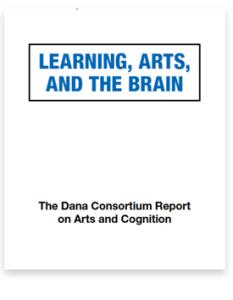
Author: Gazzaniga, Michael
Publication Year:
Media Type: Report
Summary:
Learning, Arts, and the Brain, a study three years in the making, is the result of research by cognitive neuroscientists from seven leading universities across the United States. In the Dana Consortium study, released in March 2008, researchers grappled with a fundamental question: Are smart people drawn to the arts or does arts training make people smarter? See table of contents, at right
Abstract:
In 2004, the Dana Arts and Cognition Consortium brought together cognitive neuroscientists from seven universities across the United States to grapple with the question of why arts training has been associated with higher academic performance. Is it simply that smart people are drawn to “do” art—to study and perform music, dance, drama—or does early arts training cause changes in the brain that enhance other important aspects of cognition?
The consortium can now report findings that allow for a deeper understanding of how to define and evaluate the possible causal relationships between arts training and the ability of the brain to learn in other cognitive domains. The research includes new data about the effects of arts training that should stimulate future investigation. The preliminary conclusions we have reached may soon lead to trustworthy assumptions about the impact of arts study on the brain; this should be helpful to parents, students, educators, neuroscientists, and policymakers in making personal, institutional, and policy decisions.
Specifics of each participating scientist’s research program are detailed in the appended reports that can be downloaded from www.dana.org. Here is a summary of what the group has learned:
- An interest in a performing art leads to a high state of motivation that produces the sustained attention necessary to improve performance and the training of attention that leads to improvement in other domains of cognition.
- Genetic studies have begun to yield candidate genes that may help explain individual differences in interest in the arts.
- Specific links exist between high levels of music training and the ability to manipulate information in both working and long-term memory; these links extend beyond the domain of music training. Arts and Cognition Findings Hint at Relationships Michael S. Gazzaniga, Ph.D. University of California at Santa Barbara vi Arts and Cognition: Findings Hint at Relationships
- In children, there appear to be specific links between the practice of music and skills in geometrical representation, though not in other forms of numerical representation.
- Correlations exist between music training and both reading acquisition and sequence learning. One of the central predictors of early literacy, phonological awareness, is correlated with both music training and the development of a specific brain pathway.
- Training in acting appears to lead to memory improvement through the learning of general skills for manipulating semantic information.
- Adult self-reported interest in aesthetics is related to a temperamental factor of openness, which in turn is influenced by dopamine-related genes.
- Learning to dance by effective observation is closely related to learning by physical practice, both in the level of achievement and also the neural substrates that support the organization of complex actions. Effective observational learning may transfer to other cognitive skills.
Arts & Intersections:
Categories: Creative Youth Development, Arts Education
ADDITIONAL BIBLIOGRAPHICAL INFORMATION
PUBLISHER INFORMATION
Name: Dana Press
Website URL: http://www.dana.org/books/press